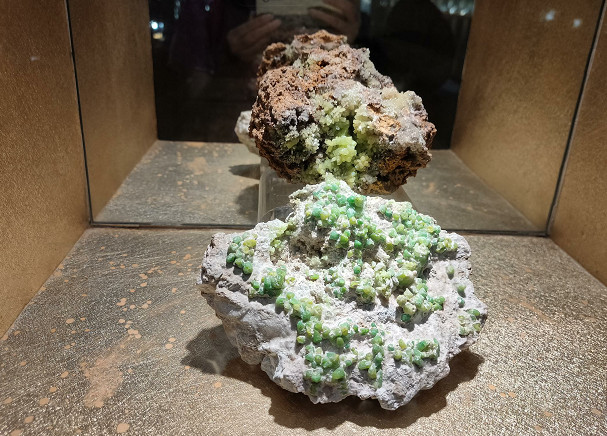Oriental Geology Science Museum, vicissitudes of Life (3) -- Shanghai 3 (8)
★ Travel location: Shanghai Pudong Oriental Geological Science Museum
The second floor of the Science Museum is the gemstone hall, and the gemstone is also the most expensive among all kinds of stones. If it can be called a gem, it must not only have a certain hardness, but also be ornamental. The ancient Roman philosopher Pliny said: "The tiny space of a gem contains the whole nature, and a gem can express the beauty of heaven and earth."

I really did not know that phosphine chloride lead ore can also be among the gems, in a sense, it is of course not a gem, but in a broad sense, it has a small output, and it is a rare mineral variety, even if it does not make jewelry, good shells are also of collection value. This mineral generally appears in different shades of green, yellow or brown, a few appear gray or white, but also because of a small amount of chromium and bright red or orange-red.

Aquamarine is a relatively famous gemstone, legend sea sapphire produced in the sea, is the essence of sea water, so the seafaring family it to pray for the blessing of the God of the sea, called it the blessing God stone. At the same time, it is also the moon stone in March, symbolizing calm and courage, happiness and longevity, anyway, are some very auspicious meanings. It and the famous emerald belong to the beryl group of minerals, relatively low hardness. The exhibits on display here are pale blue, growing in white rose-shaped Muscovite, which is a precious gem-grade mineral boutique.

The name watermelon tourmaline came from the Qing Dynasty, when Brazil's dark green tourmaline was exported to Europe as Brazilian emeralds. Because tourmaline can attract dust when exposed to sunlight, it is named suction stone, and mineralogist calls it tourmaline, which is far from the two names compared to tourmaline. Tourmalines come in a variety of colors, from colorless, pink, and red to green, blue-gray, purple, yellow, brown, and even black. Watermelon tourmaline is more special, the same stone has red and green, like watermelon skin and melon flesh, very beautiful. Its hardness is close to that of emerald, and the Empress Dowager Cixi loved tourmaline so much that in her tomb there was a blue flower worth 750,000 taels of silver.

Ruby is the fifth of the four precious stones, the mineral composition is corundum, hardness is only slightly lower than diamond. Ruby color has pink, purple, dark red, bright red, pigeon blood, the most valuable is pigeon blood. Starlight red stone in the light will reflect the charming six stars, is also a more expensive variety of ruby.

It's surprising that the plaster is on display here, because it's much bigger downstairs. As a mineral with hardness 2, it is actually far from the standard of gemstones. However, this exhibit is more precious because it contains red.

The color of spinel is very brilliant, which is no less than the tourmaline, and the hardness is slightly lower than corundum, reaching 8. Since ancient times, spinel is also a relatively precious gemstone, especially the red spinel is the most popular, and it was once regarded as ruby in ancient times. For example, the Timur ruby and the black Prince ruby were identified in modern times as red spinel. The ruby tops on the hats of the Qing Dynasty royal family and the top officials are almost all made of red spinel. The red velvet-colored spinel currently in the Moscow gold stone vault weighs 398.72 grams, which is the largest red spinel in the world. This gem originally belonged to China and was bought by the Russian envoy in 1676.

Emerald is also the world famous gemstone, is the emerald green variety of beryl, crystal hexagonal columnar shape, which is the characteristic of beryl. Its hardness is not high in the gem family, only 7.5, just because its color is particularly deep and gorgeous, so it is used as a high-grade gem.

Sapphire and ruby, diamond, emerald is known as the world's four major gems, and ruby is the same as corundum, extremely high hardness. The wonderful thing is that sapphire is not only blue, corundum other than red can be called sapphire, but in addition to blue, other colors will add its color system in front of sapphire, such as yellow sapphire, orange sapphire and so on. Of course, the most expensive or blue, cornflower blue, royal blue are extremely precious varieties. There are starlight sapphire, full, six or even twelve starlight, quite beautiful.

Feldspar is an important gemstone variety in feldspar, translucent, when rotating, it can show blue, green, orange, yellow, yellow, purple, red and other colors in a specific direction, so it is also known as spectral stone. If there are a large number of oriented acicular inclusions, they can be processed into gems to show starlight or cat's eye effect.

The color of hibiscus jade is delicate and bright, and the internal crystal often has white stone patterns, natural clouds or natural ice cracks, which are transparent or opaque, but the luster of the surface will show a light like full water or even grease, which is very warm. However, the stone degree of hibiscus jade is low, which belongs to a kind of calcite, so it is not suitable for processing as jewelry, more as ornamental ornaments.

Diopside is a more common variety of pyroxene, common colors are blue-green, yellow-green, brown, yellow, purple, colorless, white, glass luster. Transparent and beautiful diopside can also be used as a precious or semi-precious stone, which is easier to confuse with other ores.










Previous Article:Oriental Geology Science Museum, vicissitudes of Life (4) -- Shanghai 3 (9)
Next Article:[Taste buds taste on the road] Exquisite Shanghai food, favorite squirrel Mandarin fish
